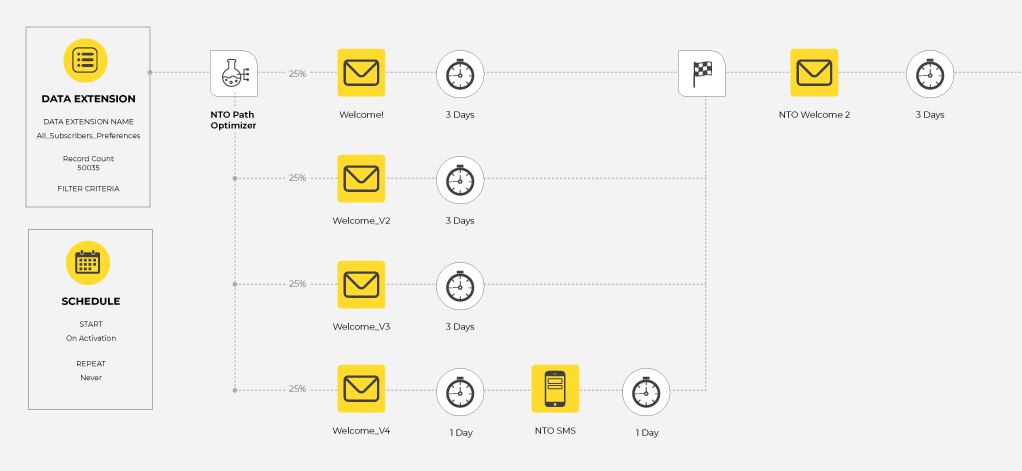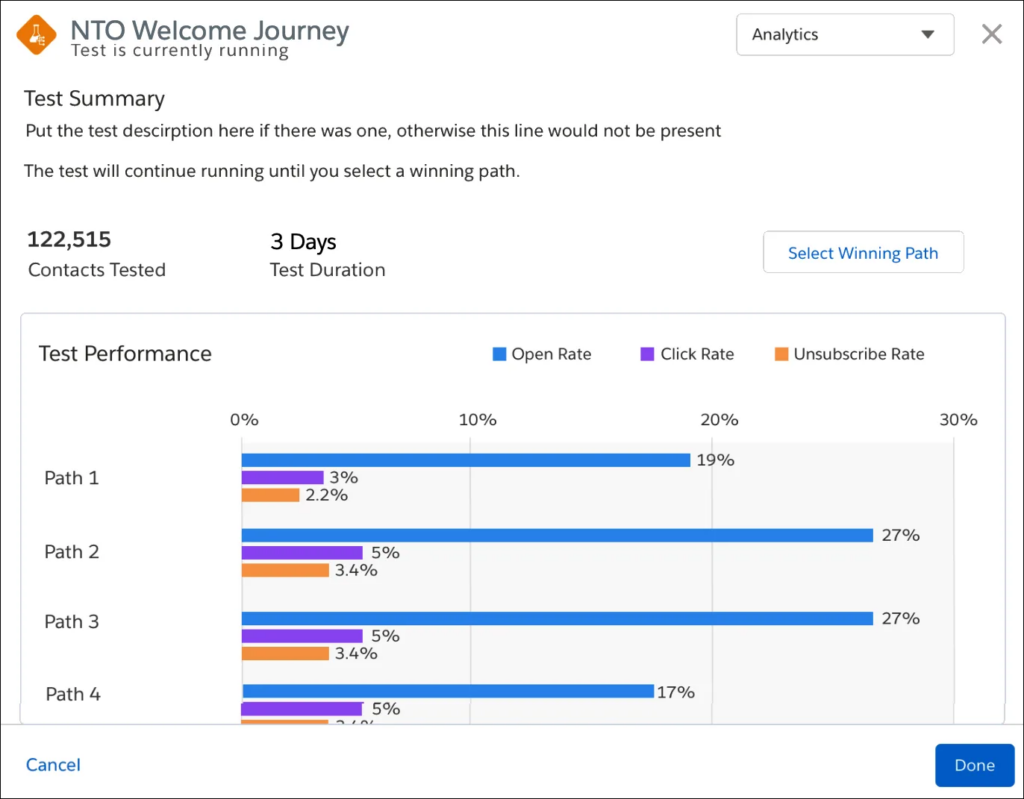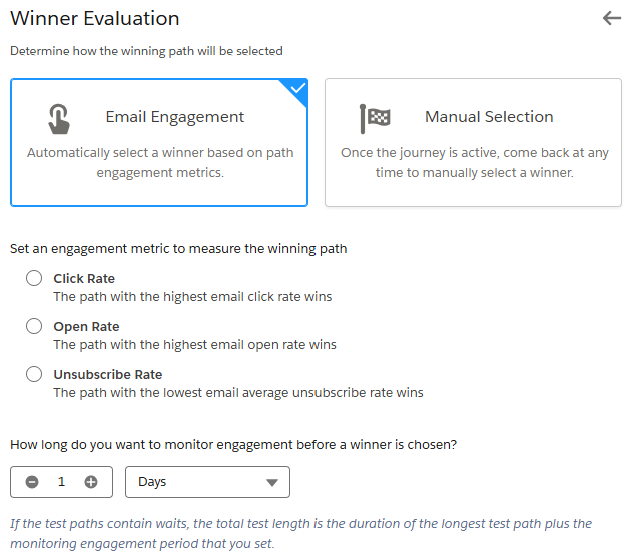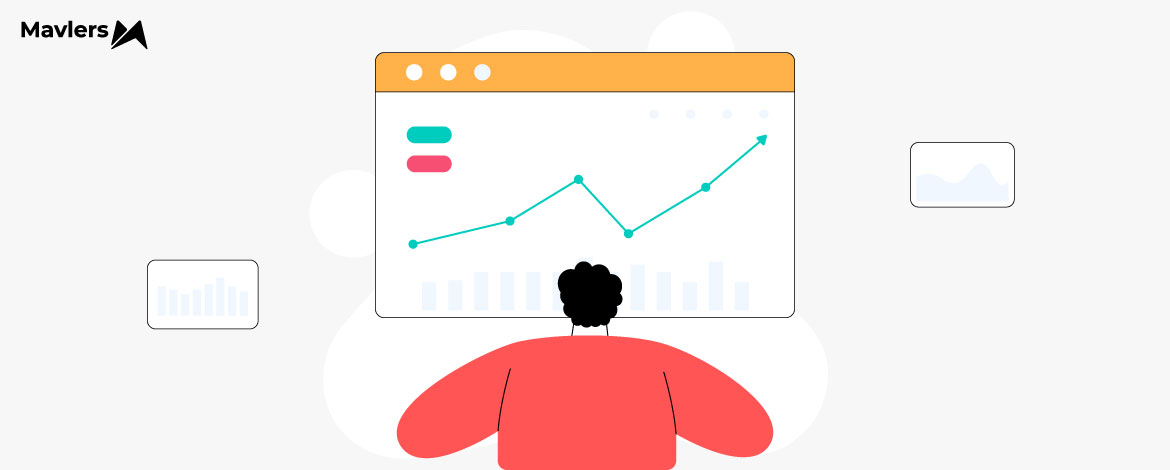Everyone talks about being customer-first. It’s the mantra of every modern business playbook. It means understanding not just who your customers are, but how they move, what they respond to, and why they engage (or don’t) at specific moments.
That’s where customer journey mapping earns its keep.
Salesforce Marketing Cloud’s Journey Builder is built for this kind of work—and it keeps getting better. One of its most useful features is Path Optimizer which helps you experiment with different journey paths, see what performs best, and adjust your approach without missing a beat.
“Path Optimizer in SFMC has helped us test different journey paths to discover which content and experiences drive the most engagement for our clients,” says Harsh Makadia, an SFMC expert at Mavlers.
In today’s guide, we walk you through how Path Optimizer in email marketing works. So, let’s get started.
What is Path Optimizer?
Key features & capabilities
The mechanics of Path Optimizer
Sample size in Path Optimizer
Wrapping up
What is Path Optimizer?
Path Optimizer in Salesforce Marketing Cloud (SFMC) is a powerful feature within Journey Builder that allows marketers to test multiple variations of a customer journey path to determine which one performs best. It’s essentially an advanced form of A/B testing, but with the ability to test more than two variations.
Here’s what Path Optimizer in Marketing Cloud does for you:
- Optimizes customer journey with Path Optimizer: It helps you understand which sequence of activities (emails, SMS, push messages, wait times, content, etc.) resonates most with your audience.
- Identifies the most effective path: By testing different approaches, you can discover what drives higher engagement, conversions, or other desired outcomes.
- Automates winner selection: You can configure Path Optimizer to automatically select a “winning” path based on predefined metrics (like open rates, click rates, or unsubscribe rates) after a specified testing period.
- Saves time and resources: Instead of manually setting up and monitoring multiple separate tests, Path Optimizer streamlines the process.
This approach is central to AI-based customer journey optimization, where data-backed insights and automation combine to drive relevance and performance. Path Optimizer is a flow control activity seamlessly integrated into the Journey Builder canvas, making it easy to drag and drop and configure within your existing journeys.
Key features & capabilities
Unlike traditional A/B testing which is limited to two variables, Path Optimizer in email marketing allows you to test up to 10 different paths within a single journey. Each path can contain different:
- Message content: Test variations of email copy, subject lines, images, or calls to action.
- Message channels: Experiment with sending emails, SMS, or push notifications at different points.
- Wait times: Determine the optimal time delays between activities.
- Frequency of sends: Test different sending cadences.
- Dynamic content: Incorporate personalized content to see its impact.
- Einstein Send Time Optimization (STO): You can even integrate Einstein STO into one or more paths to leverage AI-driven optimal send times.
Let’s say you’re setting up a welcome series.
With Path Optimizer in SFMC, you can test different versions of your first email, all within a single journey.
For example, your journey might start with four alternate paths, each featuring a different version of the first welcome email. Regardless of the variation, all contacts eventually flow into the same second email in the series.

This setup allows for efficient email path optimization, comparing these metrics:
- Contact volume
- Open rates
- Click-through rates
- Unsubscribe rates
After the testing period, the best-performing path is automatically selected based on the engagement metric you choose.
Prefer to decide manually? You can do that too, using your own performance criteria. In this manner, you get to optimize customer journeys with Path Optimizer quickly and with confidence.
The mechanics of Path Optimizer
The mechanics of Path Optimizer in SFMC can be duly summarized in the following six steps:
- You drag the “Path Optimizer” activity into your Journey Builder canvas.
2. You define the number of paths (2 to 10) you want to test and how you want to distribute contacts among them.
3. For each path, you design the sequence of activities you want to test (e.g., send Email A, wait 2 days, then send Email B vs. send Email C, wait 1 day, then send SMS).
4. You set the criteria for winner evaluation (automatic based on engagement or manual). If automatic, you also specify the engagement metric and the duration of the testing period.
5. As contacts enter the Path Optimizer, they are routed down the different test paths.
6. Once the evaluation period is complete, the winning path is identified, and all subsequent contacts entering that Path Optimizer activity will follow the winning path. The “losing” paths are essentially shut off.

Source: Trailhead
This streamlined testing supports everything from timing optimization in email automation to message sequencing and email personalization with Path Optimizer.
So far so fine. However, when using Path Optimizer, the sample size is a critical factor. Let’s delve into it in the next section.
Sample size in Path Optimizer
One of our past clients had set up a new welcome journey for their e-commerce brand using Path Optimizer in SFMC. Their goal was to test two different welcome email sequences (Path A and Path B) to see which one led to higher engagement.
For their initial test, they loaded a segment of 20 new subscribers into their test data extension.
Their Path Optimizer was configured as follows:
- 100% Targeting: All 20 subscribers were supposed to go through the test.
- Path A: 70% split (expected: 14 records)
- Path B: 30% split (expected: 6 records)
After activating the journey, when they checked the Path Optimizer analytics, the actual distribution they observed was:
- Path A: 9 records
- Path B: 11 records
This was nowhere near the 70/30 split they had set up; in fact, it was almost reversed from their expectations.
What happened?
When setting up Path Optimizer, it’s natural to expect the contacts to split precisely according to the percentages you configure. However, as we explained to our client, this isn’t always the case, especially with smaller sample sizes.
Because Path Optimizer in email marketing works probabilistically, small samples don’t always split evenly. Over a large volume, these splits will trend closer to the intended distribution, which is key for meaningful email path optimization.
When you set a 70/30 split, it means each incoming contact has a 70% chance of going down Path A and a 30% chance of going down Path B. However, with a small group of only 20 subscribers, random chance can lead to significant deviations from those percentages, as our client experienced. One or two contacts being randomly assigned differently can alter the observed split.
“Before building a customer journey in Salesforce Marketing Cloud, take time to plan your data strategy. Identify the data sources that will give you a comprehensive view of your customers, help map out key touchpoints, and support the creation of meaningful customer personas.
Surprisingly, many Journey Builder users and SFMC email specialists overlook this critical step. Don’t make the same mistake.”
— Chintan Doshi, Head of CRM, Mavlers
Keeping this in mind, here are a few tips to consider when working on Path Optimizer:
- Use large enough sample sizes: To get reliable results from Path Optimizer, you need a substantial number of contacts passing through the journey. If your test group is too small, the results will be inconsistent and misleading because of the random nature of how contacts are assigned.
- Don’t draw conclusions from limited data: If the contact volume is low, any variation in performance between paths is likely due to random chance. Wait until you have a meaningful sample size before using test results to make decisions.
- Allow for a warm-up period: When you first activate a journey with Path Optimizer, give it some time for a steady flow of contacts before reviewing results. This helps avoid skewed insights that may result from low-volume data.
- For controlled tests, use alternatives: If you need precise control over where a small number of contacts go, Path Optimizer may not be the best option. Manually segmenting your data and using Decision Splits can give you more control, although this removes the automation advantage.
- Monitor distribution early and often: Even with a healthy sample size, it is a good idea to monitor the actual distribution in your Path Optimizer reports. If you notice significant and persistent deviations from your configured percentages, further investigation may be necessary.
- Base all your decisions on statistical significance: When evaluating results, look beyond raw numbers. Focus instead on statistical significance. .
A Word on Statistical Significance
Statistical significance, just so you know, is a way to determine whether the results you’re seeing in a test—like one path in a customer journey performing better than another—are likely to be real or just due to random chance.
Let’s say you’re testing two versions of a welcome email:
- Email A gets a 20% click rate
- Email B gets a 23% click rate
That 3% difference might seem better, but is it actually meaningful, or could it just be random variation?
Therefore, statistical significance helps you answer that question by calculating whether the difference is large enough, and consistent enough, that it’s unlikely to have happened just by chance.

However, it remains unclear whether Path Optimizer bases its results on statistical significance. We explored this internally, and in most instances, the consensus was that the automated outcomes are primarily driven by basic comparisons of raw engagement KPIs.
If that’s the case, it’s important to approach the results from Path Optimizer with a pinch of salt. Because in any form of testing, statistical significance is essential to draw reliable conclusions. As Jeanne Jennings, email marketing expert, points out:
“The biggest mistake I see marketers making here is not checking their results for statistical significance. Statistical significance tells you whether your test really beat your control – or whether it was a statistical tie, with the results being within the margin of error.”
Wrapping up
Like any testing tool, the value of Path Optimizer in SFMC depends on how thoughtfully you use it.
The key is balance. Combine the flexibility of Journey Builder with smart planning around sample sizes, testing durations, and statistical rigor. Monitor performance early, remain skeptical of early wins, and let real engagement, not just gut instinct, guide your decisions.
When used correctly, Path Optimizer becomes a powerful ally in your lifecycle marketing strategy. It helps you send the right message, to the right person, through the right channel, at the right time.
Need help utilizing Path Optimizer? Book a free 30-min call with one of our Salesforce Marketing Cloud experts!


Susmit Panda - Content Writer
A realist at heart and an idealist at head, Susmit is a content writer at Mavlers. He has been in the digital marketing industry for half a decade. When not writing, he can be seen squinting at his Kindle, awestruck.
Chintan Doshi - Reviewer
Chintan is the Head of Email & CRM at Mavlers. He loves email marketing and has been in the industry for 7+ years. His track record of email marketing success covers building email programs from scratch and using data-driven strategies to turn around underperforming accounts.
Why Shopify Doesn’t Use Parent-Child Categories (And What to Do Instead)
50 Real-life Use Cases of Agentforce in Marketing